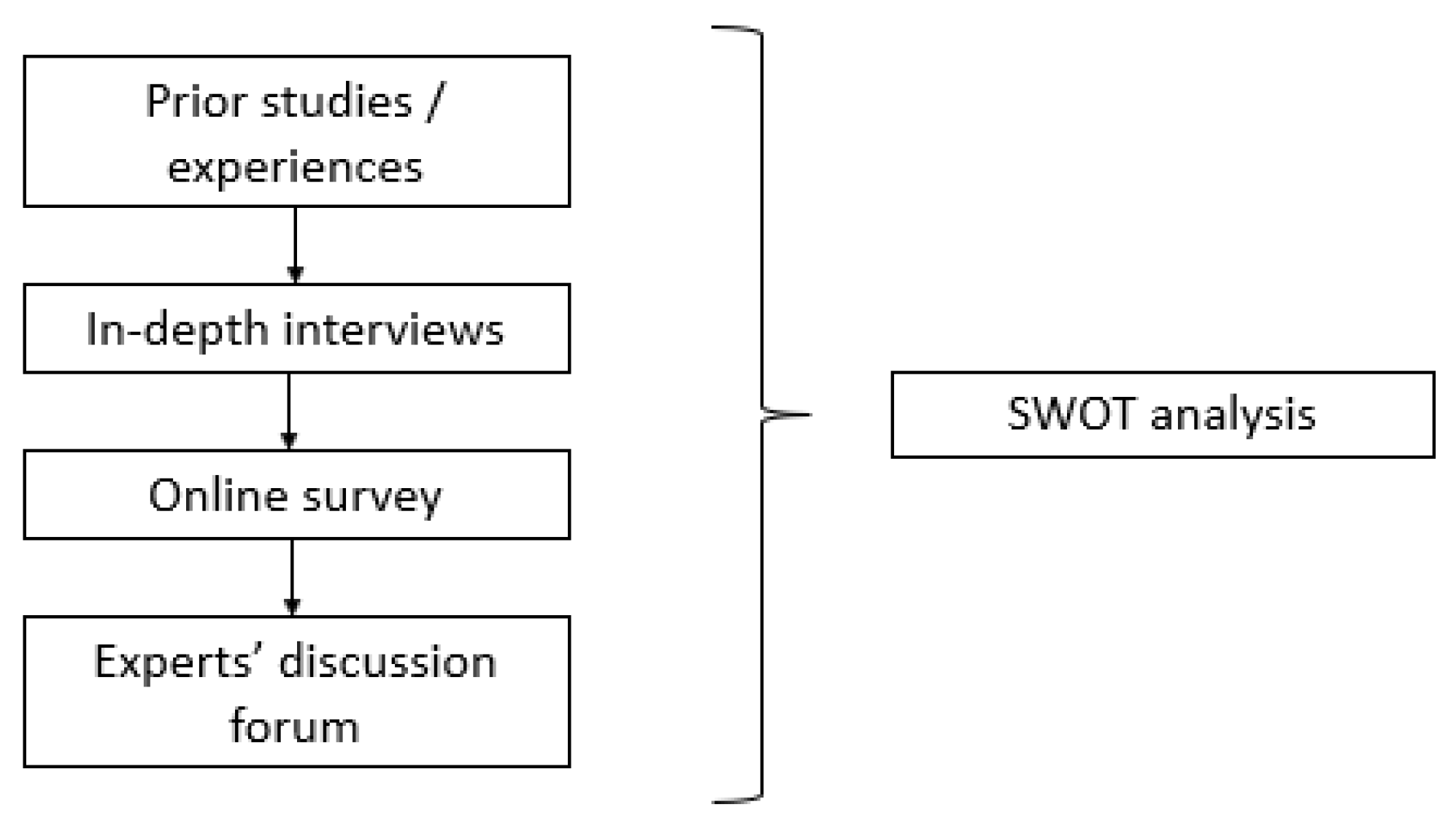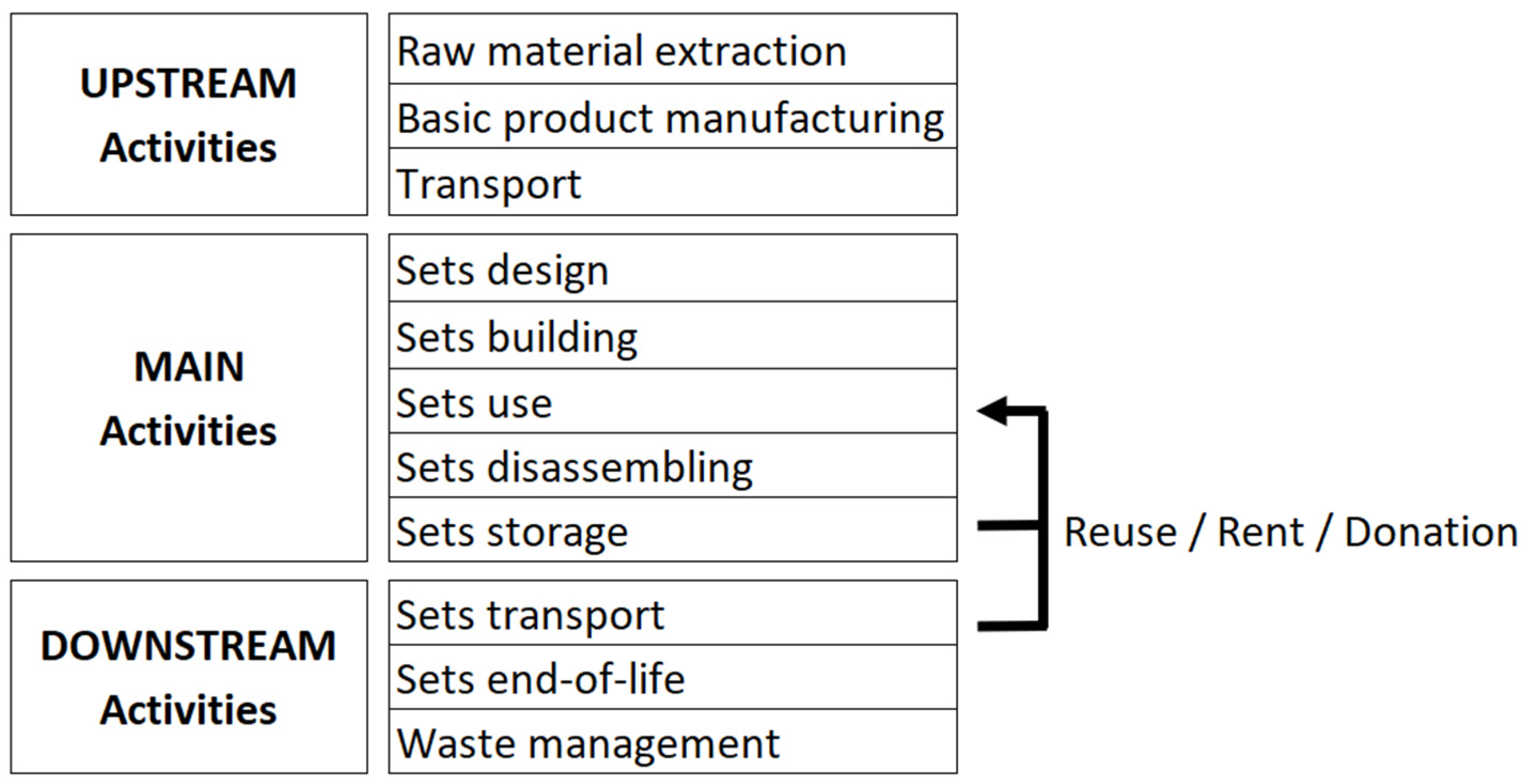To synthesize our research and integrate the insights gained with the literature review and the results of our primary research, we discuss the internal and external factors conditioning the environmental impacts and sustainability of the opera organizations and sector in the form of a Strengths, Weaknesses, Opportunities, and Threats (SWOT) analysis. As in previous social and environmental studies (e.g., [
32,
33]), the SWOT analysis aims at identifying the inherent factors of the sector that constitute an advantage (strengths) or disadvantage (weaknesses) towards the goals set, in our case, the environmental sustainability of opera sets, and the external elements that may facilitate (opportunities) or hinder (threats) their achievement.
4.1. Internal Analysis (Strengths and Weaknesses)
Creativity and innovation are at the heart of artistic creation, which is in turn a central purpose of opera houses. Whereas aesthetics and artistic criteria have been found to usually prevail over sustainability concerns in the decision-making processes of opera houses, the creativity and innovative forces within the organization are a powerful transformative asset to achieve environmental goals. This fact, paired with an increased sensitivity regarding sustainability concerns within opera organizations, as exemplified with the growing number of related initiatives, shall play an important role in promoting a shift towards more sustainable practices. Moreover, the fact that a mission of opera houses is to disseminate culture should further enhance a willingness to incorporate and share sustainability values and concerns to engage the audience with the challenges that they pose.
The interviews and experts’ forum we performed, allowed for identifying further inner characteristics of the sector that could become fundamental in its path towards sustainability. First is the fact that opera house managers are already accustomed to balancing different criteria, requirements, and concerns. The constraints and considerations to be managed in the different stages of the LC of opera sets include those related with aesthetics, the time available, budgetary constraints, the dimensions of the theatre, security measures, etc., which may frequently imply opposite criteria. Sustainability adds complexity to the decision-making processes but, at the same time, it may turn out to be a conflict-resolving determinant that may be introduced in the working conditions of suppliers and subcontractors, designers, production, and post-production services.
A related trait of the sector is the fact that there exist already tight collaborations across organizations. These well-established relations could act as channels to standardize and disseminate protocols for its transformation to achieve environmental goals. These collaborations include, on the one hand, the close relation that opera houses have with their suppliers, subcontracted workshops, artists, technical professionals, public and private cultural institutions, etc. On the other hand, different opera theatres frequently collaborate to develop joint productions and venues. Moreover, the opera sector counts with multiple associations, such as Opera Europe, Opera America, Opera for Peace, Fedora, or RESEO, amongst others, which have the aim to promote collaboration and innovative practices. This intense collaborative framework constitutes an ideal starting point to push forward the sector towards setting sustainability targets. These common goals could emerge from sustainability pioneering pilot experiences aiming to set standards for the sector.
Several aspects of the opera sector and their organizations were outlined as inherent weaknesses to be overcome in their path towards sustainability. At an organizational level, the results of the interviews, the survey, and the experts’ forum similarly pointed out that there is a lack of involvement and alignment of the different levels of the organizations with regards to sustainability objectives. This relates with, on the one hand, the existence of other predominant criteria and, on the other, with a scarcity of information regarding the impacts and potential alternatives of action that the decision-makers should take into consideration. When taking decisions, economic and artistic criteria generally take precedence at the managerial level and are frequently perceived as being opposed to sustainability criteria. This poses an important barrier for technical departments to incorporate sustainability considerations into their decisions regarding the materials and technical solutions incorporated in the productions.
Moreover, the temporary and ephemeral nature of a good number of opera venues and the specificity of requirements that artistic creations impose on the characteristics of sets, as well as the intellectual property rights of productions may substantially reduce the possibilities for organizations to consider standardizing structures and making them compatible for different performances. Their standardization would enable the reuse of sets to reduce the associated environmental impacts.
The survey performed, and later corroborated in the discussion forum, found that opera organizations do not systematically collect detailed information regarding the use of materials, energy, and the generation of waste. Obtaining such information would be fundamental to developing a strategy to enhance organizational and sectorial sustainability. There is an urgent need to assess the impacts and reconsider the type and quantity of materials used. A common perception amongst technical professionals is that reused, recycled, modular, and reusable components that facilitate assembly and disassembly and extend the lifespan of materials have not been sufficiently prioritized. Similarly, attention should be placed on minimizing the use of new virgin materials from unsustainable distant sources requiring significant transport. Sets and scenery mainly use steel, softwood, laminated materials, and plastics which have considerable environmental footprints. The most damaging materials given their scarcity, manufacture, or chemical harm are identified to be polystyrene, PVC, unrecycled steel, and tropical hardwoods. As stressed in the experts’ forum, requiring suppliers’ information and evaluating the footprint of the materials used and their storage management is quintessential to evaluating the alternatives of action. Also, making shows sustainably would require reducing transport and deliveries and prioritizing those with lower emissions, promoting networks and sharing systems to boost reuse initiatives. Achieving sustainability implies considering sustainability since from the outset it involves planning, design, and managing of the production, developing collective responsibility and teamwork, collecting and communicating data on the use of resources, and facilitating tools and information (such as material passports, material inventories, or carbon calculators) and training.
4.2. External Analysis (Opportunities and Threats)
The opera sector is part of the cultural and arts industry which is experiencing dramatic changes, especially due to two external factors: the advancement of digitalization and technical solutions and the irruption of the COVID-19 pandemic. Both pose important opportunities and threats with respect to the challenges of pursuing more sustainable productions.
The sweeping changes brought about by the digital and technological revolution have had a dramatic effect on the cultural and arts industry. On the one hand, technical innovations have transformed opera design and production, in many instances reducing the use of energy and materials, enabling the use of alternative sources of energy, and reducing the generation of waste; however, as our research shows, a predominant criterion of the opera sector is that of the aesthetic excellence of artistic creations, which has often prevented even more radical changes to achieving environmental sustainability. The digital revolution experienced is also linked with changes in the lifestyle, preferences, and behavior of consumers of the arts and cultural sector. The emergence of alternative forms of recreational activities, the improved quality of home sound and image systems, and the perception that “classic” forms of culture such as opera and ballet may be outdated and elitist, pose an important threat to the sector. Thus, opera organizations may consider engaging in actions to widen its audience to align with the changing values of society. Embracing sustainability concerns at the corporate level as well as in their designs and even as a theme for new creations, such as that which the association Opera for Peace is promoting, could represent an opportunity to achieve this goal whilst improving the public image of opera organizations. The existing parallelism between artistic values and the concepts of a circular economy and sustainability in aiming to boost human progress could foster the possibility for creating new paradigms within the sector and for generating new opportunities for opera artists.
The COVID-19 pandemic has put the cultural industry in the spotlight due to the need to limit the audience capacity of public performances, which has implied an important economic tension for the organizations and professionals involved. As much as the reduction of resources and the need to ensure sanitary conditions has potentially diverted the attention of opera house managers from sustainability concerns and in some instances increased environmental impacts, the need for a change of paradigm and the implementation of new practices have shaken organizations. This turmoil may represent an opportunity to push forward structural reforms. Aligning the mechanisms and requirements of public recovery funds that the cultural sector is bound to receive with sustainable goals can act as an important trigger in this respect. The increasing awareness and concern of public bodies and administrations with the need to reduce environmental impacts shall play a substantial role in pushing the opera sector towards enhanced sustainability practices.
Table 8 presents a summary matrix of the SWOT analysis. The internal strengths and weaknesses encountered align with the need for the opera sector to accommodate new parameters and constraints in the design processes of opera set productions additional to the traditional governing criteria. The perception of rivalry between economic, artistic, and sustainability criteria ought to be reassessed. Its analysis should test whether the incorporation of certain sustainability practices hinders artistic quality standards, freedom of authorship, and creativity, as well as the economic results of productions. This research should ultimately aim to contribute to developing new practices to prevent these potentially detrimental interlinked effects. Aligned with this, as was mentioned in the experts’ forum, it becomes paramount that sustainability is sponsored from the top managerial levels and integrated in the organizational culture. Sustainability management, impact assessment, and reporting should emerge as a function within the organizations to involve, capacitate, and empower the different stakeholders (producers, directors and designers, production managers, production staff, makers, and communication and PR units), and to generate a common operationalization of sustainability by developing toolkits, handbooks, guidelines (including materials’ passports and inventories) and disposal protocols to push forward progressive actions towards environmental objectives.









